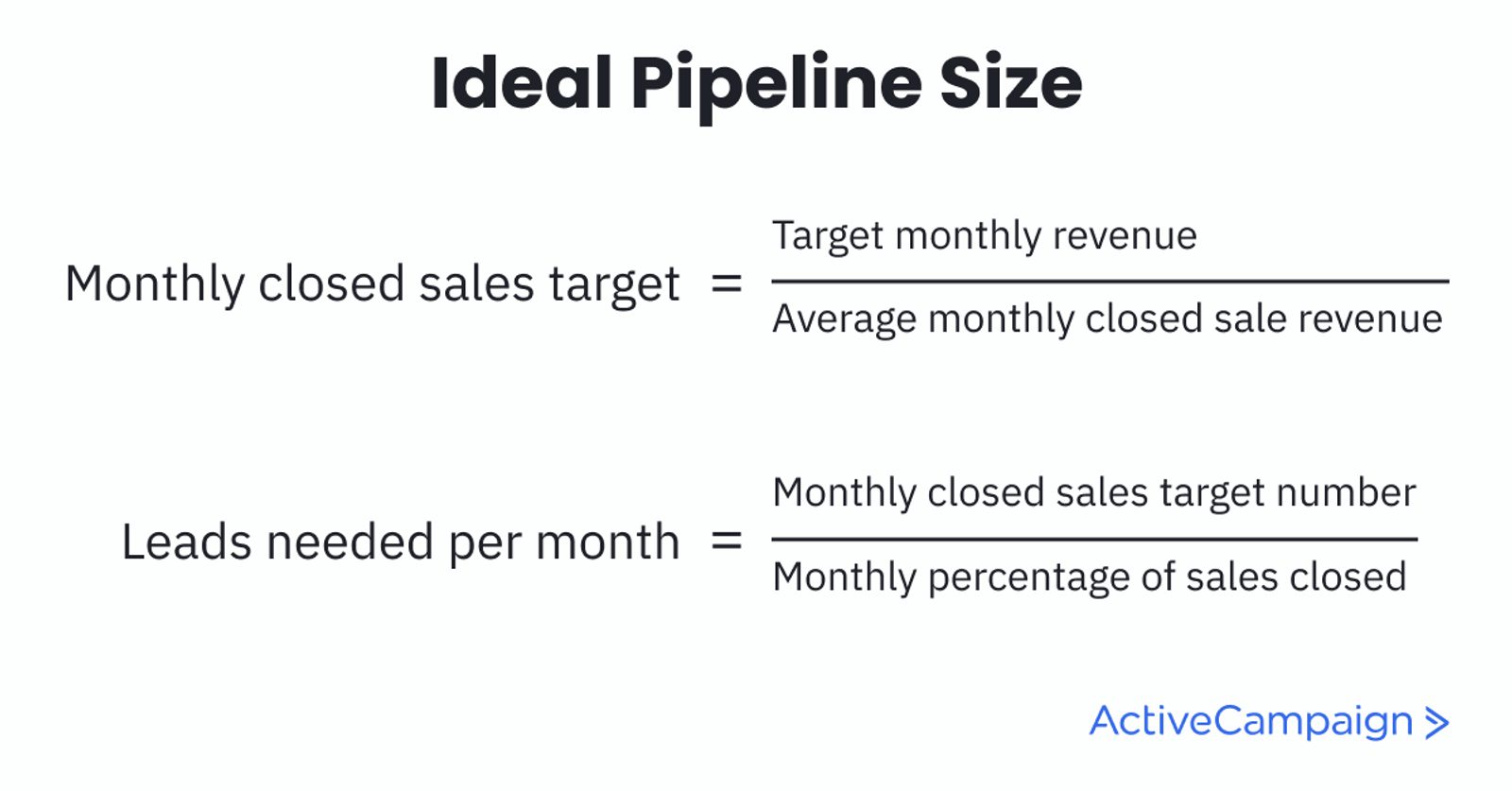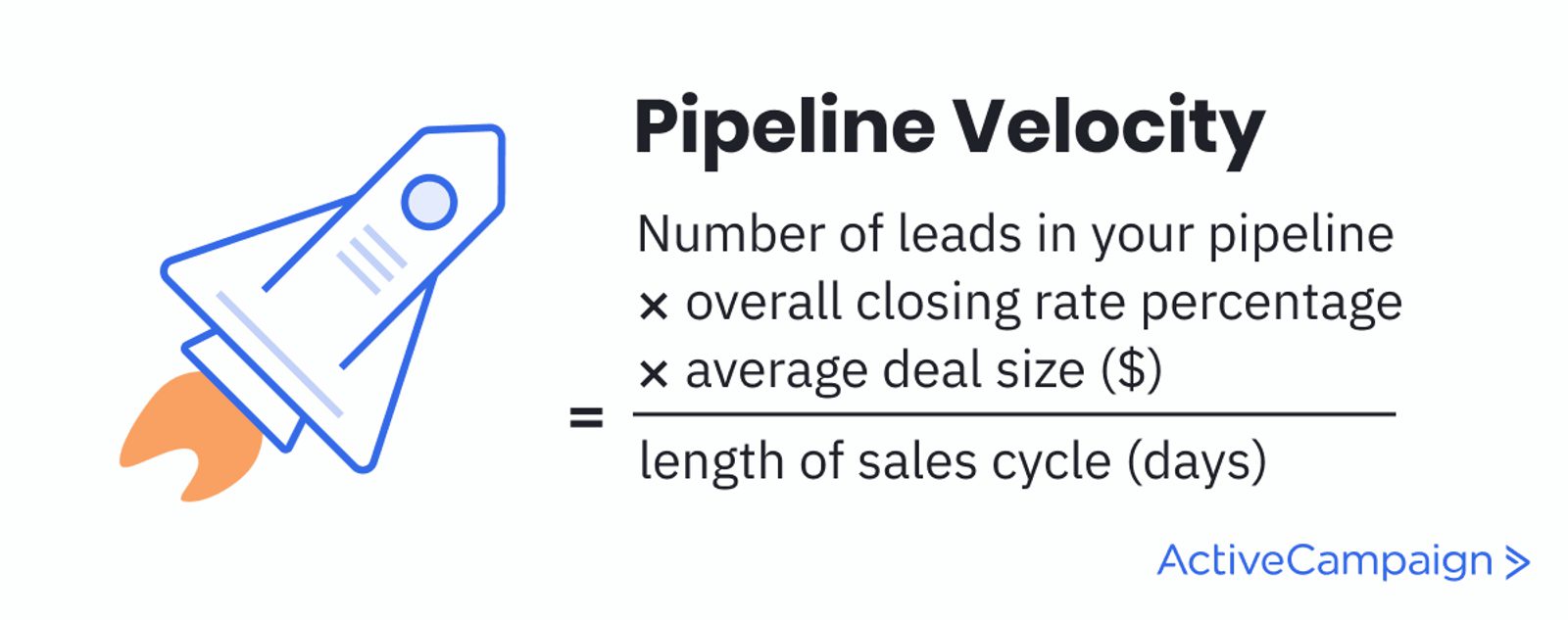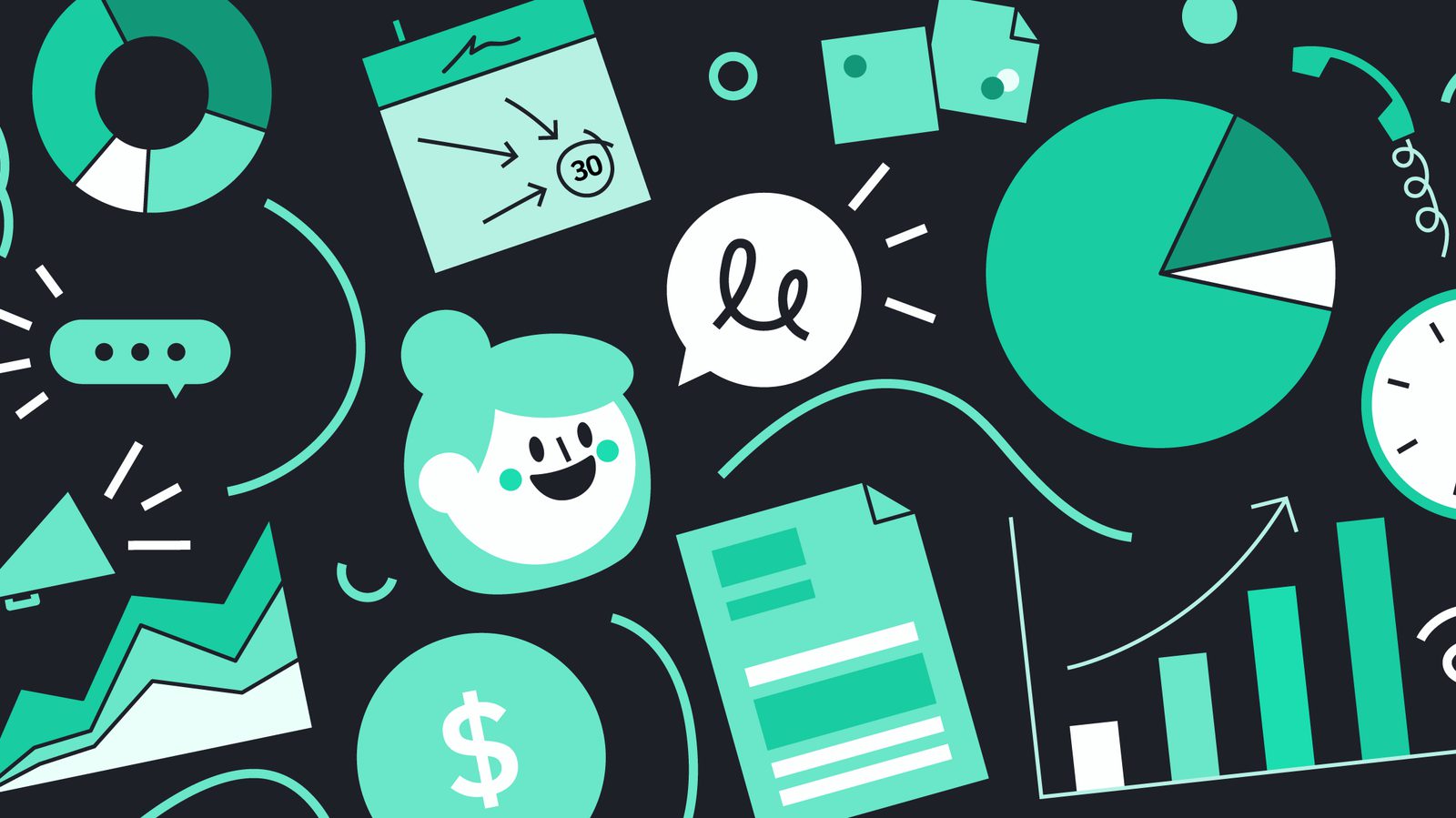In this article, you’ll get answers to these questions about sales pipelines:
- What is a sales pipeline?
- What’s the difference between a sales pipeline and a sales funnel?
- What are the stages of a sales pipeline?
- How do you build a sales pipeline?
- How do you manage a sales pipeline?
- What metrics matter in your sales pipeline?
- What does an automated sales pipeline look like in action?
What is a sales pipeline?
A sales pipeline is the steps you take to turn a potential customer into a paying customer. Sales pipelines show you how many open deals you have and which deals need attention. A sales pipeline is essential for businesses that want to reach their weekly, monthly, or quarterly sales quotas.

A sales pipeline makes sure that every salesperson knows the next step they need to take when working on a deal.
Why do you need a sales pipeline for your business?
If you don’t use a sales pipeline, you won’t have the insight you need to see if your sales process is effective—you’ll just have guesswork. The increased accountability a customer pipeline gives you makes it easy to see where opportunities exist for improvement.
A sales pipeline for your business will:
- Predict revenue
- Track your leads
- Simplify sales
- Define your marketing strategy
Pipelines, Optimized.
What’s the difference between a sales pipeline and a sales funnel?
A sales pipeline describes the steps that your sales team takes while qualifying leads and closing deals. A sales funnel describes the customer journey as people go from learning about your company to becoming a customer.
A sales funnel visually represents people as they advance through the pipeline stages. It’s shown as an inverted pyramid where potential customers enter at the top.
Qualified leads “funnel” down through the sales process, so the funnel narrows as the number of qualified leads drops. At the bottom of the sales funnel are the successfully converted customers.

A sales pipeline looks at the steps a business takes throughout the sales process—the sales funnel looks at the number of people who complete the customer journey.
What are the stages of a pipeline?
Here are some of the most common sales pipeline stages:
- Contact
- Qualification
- Meeting
- Proposal
- Closing
- Retention
There are no hard rules for what stages your sales pipeline should include—your options are boundless. Pipeline stages will differ between companies (and even between products).
Still, these stages are a pretty good place to start.
But what does each of these basic pipeline stages actually mean?
1. Contact
Before you can make a sale, you need a real-life person who's interested in what you sell.
A sales pipeline journey begins when a potential customer learns about you. You can aid that discovery in 2 ways:
- Lead generation: Marketing strategies used to attract and build interest in your product or service. A one-to-many approach.
- Sales prospecting: An active process to search out likely customers to buy your business’ product or service. A one-on-one approach.

Here are some ways to generate leads and prospects for your business:
- Networking: Sometimes, the human touch is best. Talk to a person on the phone (or in person), and you’ll quickly know if they’re your ideal customer—or even a valuable referral source.
- Advertising: Products live and die with their marketing campaigns. If done correctly, your potential customers will come to you.
- Social media: Find your customers where they live. Use social channels for marketing research and to connect with potential leads.
- Cold outreach: Cold calls and cold email marketing can be effective if done right. With targeted outreach, introduce relevant value to people who haven’t heard of you yet, and they’ll be glad they now have.
- Events: Trade shows and other events are a goldmine for potential leads. After all, your target market is gathered in 1 place. And they’re there to learn about products and services just like yours. Don’t forget your swag.
2. Qualification
Is your lead ready for sales engagement?
To make a good guess about a lead, you must qualify them. Lead qualification is a process to determine if a lead has a high chance of converting into a customer—particularly a satisfied long-term customer.
Lead qualification is valuable because it saves time (and your bottom line). Pouring energy into someone who drags out the sales process—and still might not even buy—is a bad use of your limited resources.
So how do you qualify leads as worth your time?
One straightforward way is through BANT. BANT is a sales lead qualification strategy designed to identify prospects worth pursuing.

What does BANT stand for?
- Budget: Does the lead have the necessary budget to purchase your product?
- Authority: Does the lead have authority to make buying decisions, or are there other people you need to talk to?
- Needs: Does the lead have a need or problem your product can solve?
- Timeline: When does the lead plan to make a purchase?
When you have qualified leads, how do you decide which ones to make your priority?
Luckily, there’s a step-by-step process that decides for you: Lead scoring.
3. Meeting
After you qualify your leads, it’s the right time to set up a meeting—whether that’s face-to-face, phone, or even live chat. This meeting is where you:
- Get to know your potential customer
- Get a sense of the goals they’re trying to accomplish
- Learn more about what they’ve already tried to achieve those goals
It’s also where they learn more about you.
Specifically, why should they buy from you?
During this demo stage, be prepared to explain what you offer in detail, the advantages of your product over others, and be ready to overcome any objections to purchasing your potential customer may have.
To prepare for a sales meeting, you must:
- Research: Do the homework on your potential customer. Know who you’ll be meeting, study their market, and turn to Google for articles or news about them and their industry.
- Review: Go over your pitch and make sure it’s clear and concise. Use the language your customers use. Have people with no knowledge of your product read your pitch. Does it make sense to them?
- Prepare: Create a list of personalized questions in advance. Not only will you get the information you need to move them to the next stage, but you’ll also show the client your commitment to them. And while you’re at it, prepare responses to possible questions you might get.
- Rehearse: Hold a rehearsal meeting in advance of the real deal. Practice your product demonstration. Don’t leave it until the last minute in case you realize you need to make tweaks to your pitch.
4. Proposal
The proposal stage of a sales pipeline is when you ask your lead to become a customer.
If the potential customer signals they’re ready to buy, give them a detailed proposal. The details of the proposal will vary depending on the product and service.
Some best practices for a sales proposal are:
- Keep it short
- Keep the language as simple as possible
- Customize your proposal template for each lead
- Pitch the solution to their problem, not the product
- Propose multiple options at different price levels
- List your price points from highest to lowest
- Use infographics
Visuals, in particular, are very important as 40.8% of marketers stated that original images such as infographics and illustrations helped them reach their marketing goals in 2020.

Remember, there’s still a chance the lead could change their mind, even at this penultimate stage.
Your sales proposal shouldn’t have any curveballs—it should be a natural continuation of the qualification and meeting pipeline stages. It should feel like the natural next step in the relationship you’ve built.
5. Closing
The only leads in the closing sales pipeline stage are those who have signed a contract or made a purchase. They’re no longer a potential customer—they’re a paying customer.
Congrats—you’ve made the sale! Time for a well-earned nap, right?
6. Retention
Hold up a minute there. You want to keep your new customer, right?
Don’t put on a sleep mask and click play on that whale-song playlist quite yet.
You might have thought closing was the end of the pipeline. After all, you made the sale, right? What else could there be?
It turns out, a lot. In fact, the probability of selling to an existing customer is 60%-70%, while you’re only about 5%-20% likely to sell to a new customer. So, a strategy to keep your customers happy is a critical stage of nearly every sales pipeline.

Include retention in a sales pipeline to:
- Keep customers engaged
- Create opportunities for feedback
- Turn customers into advocates
A retention stage in your sales pipeline is also good for your bottom line because loyal customers are more likely to purchase future products, upgrades, or premium services.
How do you build a sales pipeline?
You can build a sales pipeline with these steps:
- Identify your ideal customer
- Determine your pipeline stages
- Discover triggers
- Calculate the ideal size of your pipeline
Identify your ideal customer
What does your ideal customer look like?
There are loads of questions you can ask as you work to understand your audience (we’ve included some of them for you below). Ultimately, 2 critical questions come before everything else:
- What does your customer want?
- How does your customer talk about what they want?
Here are a few resources we’ve put together to help you understand your ideal customer:

Once you’ve ironed out your customers’ pain points, you can dig into other questions. Like:
- Who’s your ideal customer?
- What are their goals and priorities right now?
- What are their values?
- What are their demographics?
- Gender
- Age
- Location
- Industry
- Income
- Education level
- What are your ideal customer’s pain points?
- What challenges do they face?
- What problems does your product solve for them?
- Of all your products’ benefits, which is the most important to them?
- What is the greatest pain point that your product or service solves?
- What are your ideal customer’s objections?
- What concerns could keep them from buying?
- Why should they buy from you instead of another business?
- Historical customer data
- What type of customers currently show the highest conversion rate?
- What type of customers buy products or services with the highest purchase value?
- How long does it take current customers (on average) to close?
- Ideal customer forecast
- How does your product improve your ideal customer’s life or work?
- What happens if they don’t use your product or service?
As you dig deeper to define your ideal customer, it’ll feel like you’re carving down the number of leads going into the pipeline—and you are.
Choose your pipeline stages
Are you selling a product to your customers, or are you selling your pipeline?
A buyer’s journey is the process people go through to become aware of, fully evaluate, and finally decide to buy your product or service. Your product only exists because of the customer, so the best sales pipelines match the buyer journey your customers go through.
If you build a sales pipeline with steps just to have steps, you don’t put the customer first. You put the pipeline first—and ask leads to follow your journey.

Research shows that 67% of the buyer’s journey is digital. So, keep that in mind when creating your journey.
Here’s how to decide what your sales pipeline stages should be:
- Identify the major steps in the buyer’s journey your potential customers go through:
- Awareness: In the discovery stage, the lead realizes they have a pain point or need
- Consideration: In the evaluation stage, the lead has defined their goal or challenge and researched possible solutions
- Decision: The lead compares solutions and makes a purchase decision
Discover triggers
When you decide how to build a sales pipeline, timing is everything. If you don’t advance a potential customer who’s signaled they’re ready for the next stage of your pipeline, you can lose contact with them.
Your potential customer may look for someone who’ll recognize they’re ready to buy.
When you build pipeline stages, identify actions that suggest your lead is ready to move to the next stage.
Then you can trigger your follow-up based on actions the lead takes, like when they:
- Sign up for your mailing list
- Order samples
- Get a quote
- Request a demo
- Complete a trial period
What are ways to encourage a trigger action?
- Send more follow-up emails
- Make it easier to order samples or trials
- Increase phone or chat support
- Refine website landing pages
- Offer value incentives for completed trials
Calculate the ideal size of your pipeline
How big does your sales pipeline need to be so you can hit your targets?
If you make your pipeline goals too high, your sales goals will be impossible to hit. But too small, you leave leads (and money) on the table.
There’s no magic number, but there are formulas you can use to determine your monthly closed sales target and the number of leads needed to reach those sales. From there, it’s easy to divide those leads across the salespeople working your pipeline.

First, you need to answer how many closed deals you need every month to hit your sales target?
Take your target monthly revenue and divide it by your current average closed sale revenue.
That’s how many closed sales you need to hit your target monthly revenue.
| Example: If your goal is $100,000 a month in sales, and your average order is $500, youâll need to make 200 sales a month to hit your target. |
Okay, so how many leads do you need to reach your closed sales target?
Divide your target completed sales number by the percentage of closed sales every month.
| Example: If you need 200 sales to hit your target revenue goals and close 80% of your sales on average, you need 250 possible customers every month. |
Then divide your goals by the number of salespeople. So if you have a 10-person team, each salesperson should follow up with 25 leads a month.
Continue to iterate and refine your sales process because while you now have actionable goals in place, there’ll always be variables. Sales reps closing rates will vary by stage, and you may have historically higher- and lower-performing months.
How do you manage a sales pipeline?
When you finish making a sales pipeline, you might think the sales process is now hands-off. But do your leads become customers—or do they leak through overlooked cracks in your pipeline?
Poor sales pipeline management can lead to a business suffering financial losses—or even failing.
How can you keep your sales pipeline healthy?
Here are 9 tips for managing your sales pipeline:
- Invest time and resources on sales pipeline management training and have regular meetings with your team to discuss:
- Leads currently moving through the pipeline
- Likely leads that were disqualified in a late sales stage. Why were they lost?
- Leads (especially balky ones) that were won. What made them decide to buy?
- Train your team to use the pipeline. 73% of salespeople use technology to close more deals. If your sales team knows the pipeline and the tools to use in each stage, they’ll convert more leads into paying customers.
- Follow up: Most salespeople give up after only 2 calls—while the majority of customers (60%) say “no” 4 times before finally saying “yes.” This means that if your sales team isn’t following up enough, you’re missing out on a massive amount of customers.
- Keep it short: The longer your sales process, the more chances your potential customer has to change their mind or find a different product to solve their problem. Sales pipelines are only as effective as they are efficient.
- Work for referrals: People are 90% more likely to buy from a business after a word-of-mouth recommendation.
- Collaborate with marketing: Align your sales and marketing language because people qualify themselves when sales and marketing are collaborative.
- Clean your pipeline: If you don’t regularly clean your sales pipeline, it can start to get downright messy—which will make it inefficient. Check your sales pipeline deals for:
- Leads who have gone radio silent
- Deals that have been stuck in 1 sales stage longer than normal
- That details and notes on each lead are up to date
- Partner up: Partnerships are a cost-effective way to expand your presence and generate new leads. And even better, it can improve existing customer loyalty by providing access to new benefits and products.
- Be open to change: Constantly ask “why?” when it comes to your sales pipeline. Focus on your goals. Test every stage for its impact and urgency. Questioning your stages leads to new ideas and innovations that’ll directly impact how you do business.
We have several in-depth articles on ways to manage your sales pipeline:
What metrics matter in your sales pipeline?
“The road to success is always under construction.”
-Lily TomlinIf you don’t track your metrics, how do you know if your sales pipeline is effective?
Review pipeline sales metrics to give you an idea of pipeline health, sales activity, and stage conversion rates. These give you an accurate way to forecast sales and revenue.
What metrics matter in a sales pipeline?
- Number of leads: How many leads have been qualified?
- Average deal size: How much money does your average sale bring in?
- Sales cycle length: How long does it take to close a deal?
- Close ratio: What percentage of leads convert to actual sales?
- Average deal lifetime: How long is a deal in your pipeline before they’re won or lost??
With sales pipeline metrics, you can determine your pipeline velocity and the speed at which leads move through your pipeline. Pipeline velocity helps forecast revenue.

The formula for pipeline velocity is:
Number of leads in your pipeline x overall win rate percentage x average deal size ($) / days in the sales cycle.
The changes in your pipeline velocity metric over time are often more important than the actual number. If you multiply your daily rate by the number of days in the month, your monthly revenue forecast will be more accurate.
What does an automated sales pipeline look like in action?
Airtame is a company that makes tech that lets you share your screen from any device. Airtame uses ActiveCampaign’s lead scoring to make its sales pipeline more efficient.
Automation does the heavy lifting of lead nurturing so that only the most qualified leads reach the sales team.
Airtame tracks 2 separate lead scores to improve their conversion rates:
- Customer Fit Score. What’s the lead’s profile, and how close is it to Airtame’s ideal customer?
- Engagement Score. How often is the lead interacting with Airtame’s emails and other marketing?
Customer Fit and Engagement lead scores get updated based on activity and information provided. The 2 lead scores are added together. If the combined score is high enough, the sales team gets tagged in to help.
How does Airtame update its lead scores? They track:
- Which lead magnet they came through
- What information the contacts provide
- Their level of website interaction
You can update a lead score based on almost anything you can track in ActiveCampaign. Airtame chose these criteria because they found that certain types of contacts were more likely to become customers.
Keeping track of your pipeline leads is critical to your business's long-term success. CRM and marketing automation tools can be powerful assets for building your sales pipeline—and keeping your sales process healthy.

ActiveCampaign has a comprehensive CRM that lets you manage every stage of your sales process. It’s highly customizable, so it adapts to your sales pipeline needs—no matter what your industry is.
ActiveCampaign’s CRM lets you:
- Accurately project revenue
- Score leads
- Assess the strong and weak stages of your lead pipeline
- Easily identify which deals are the most winnable
- Keep track of which deals your team members are responsible for
With these features combined, you can create an automated sales pipeline that grows your business.
FAQ
What are the most common sales pipeline mistakes?
Some of the most common sales pipeline mistakes that many businesses make include:
- Not getting clear on buyer intent
- Failing to identify the right lead qualification process for their business offerings
- Neglecting lead nurturing
- Not segmenting their leads
- Neglecting pipeline tracking
- Not recording data effectively
- Ignoring existing customers
- Neglecting their follow-up process
What is a sales pipeline review?
A sales pipeline review is an internal business meeting where reps speak to their sales managers about the deals in their pipeline and how they’re progressing. In these meetings, sales reps can discuss any obstacles keeping them from closing deals and ask their managers to help them come up with a solution.
As such, a sales pipeline review can also help managers determine if there are any recurring issues and whether they need to make adjustments to the pipeline stages.
How can I run a sales pipeline review?
Depending on the size of your company and sales team, you can decide whether you want to run a sales pipeline review meeting for your entire team at once or divide them into smaller groups. From there, you need to decide how frequent these meetings should be (weekly, bi-weekly, or monthly).
Then, you can go ahead and ask each rep to provide a summary of their deals, identify common obstacles, and create action plans to move the deals forward.
Create your sales pipeline
Creating an effective sales pipeline for your business can do wonders for your employees and customers.
Not only will a pipeline make your sales team’s job so much easier and keep them loyal to your company, but it’ll also show your customers that you’re committed to effectively guiding them through the entire customer journey.
Don’t have a well-structured customer journey? Learn how to create a customer journey map that’ll help your business grow.








